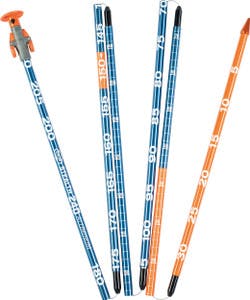Avalanche probes
- (17)Mammut Probe 280 Speed Lock$108.95
- (13)Mammut Carbon Probe 280 Speed Lock$144.95
- (0)Backcountry Access Stealth Probe - 330cm$129.95
- (0)Black Diamond Quickdraw Pro Probe 320$119.95
- (37)Mammut Barryvox 1 Tour Package$578.95
- (0)Backcountry Access Tracker 4 Rescue Package$599.95
- (0)Ortovox Aluminum 320+ Pfa Probe$119.95
- (0)Black Diamond Quickdraw Pro Probe 280$99.95
- (0)Backcountry Access Stealth 300 Probe$119.95
- (28)Mammut Probe 320 Speed Lock$118.95
- (0)Backcountry Access Stealth Probe - 240cm$99.95
- (0)Ortovox Carbon 280+ Pfa Probe$149.95
- (0)Backcountry Access Stealth 240 Probe$99.95
- ‹
- 1
- ›
Compare (0)
Avalanche probes: Essential tools for backcountry safety
Avalanche probes are lightweight, collapsible poles made from aluminum or carbon fiber. Standard probes measure 240–300cm, but if you’re exploring areas with deep snowpacks, a 320cm probe is a smart choice. Beyond avalanche rescues, probes have additional uses in the backcountry, such as measuring snowpack depth, testing the strength of crevasse bridges or checking the stability of cornices (overhanging snow on a steep drop). This versatility makes them a valuable tool for avalanche safety gear and training. Once an avalanche beacon has brought you close to a buried person, the next step in an avalanche rescue is using a probe to locate their exact position. Signals from transceivers can be affected by snow depth, debris and orientation, which means pinpointing the victim’s location requires a probe. A probe helps identify the precise spot where your group should focus on digging, making it an essential part of the rescue process. At MEC, you can find a wide variety of avalanche probes from several outdoor gear brands like Backcountry Access, Mammut, Black Diamond and more.
Training, practice and maintenance
Using your avalanche probe correctly and effectively requires practice. Rescue teams use a grid search pattern to systematically cover the area where a victim might be buried. Training ensures that you can deploy and use your probe quickly and efficiently, which is vital when time is of the essence in an avalanche scenario. Consider practicing regular drills with your adventure group to sharpen your skills and always be ready for the unexpected.
To ensure a reliable performance, regular maintenance of your probe is crucial. The cord system that secures the pole sections can wear out over time, especially with frequent use. Check that the cord operates smoothly and that the sections lock firmly in place when the probe is deployed. A malfunctioning probe could jeopardize a rescue, so replace worn or damaged parts promptly.
Working as a team
Avalanche rescues are team efforts, and everyone should be comfortable with their gear. Every group member must know how to deploy a probe, use it in coordination with transceivers, and switch seamlessly to shoveling once the victim is located. A well-trained group working together can save precious minutes during a rescue.













